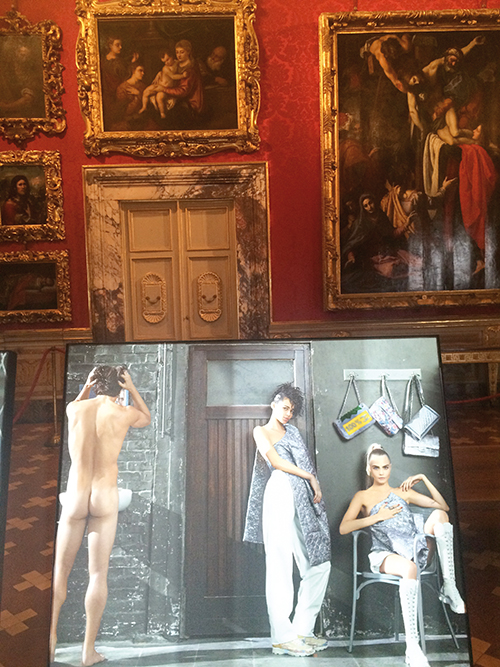A full year after his departure, the museum reform undertaken by Dario Franceschini, the Minister for the Arts and Culture, is showing its first results. There isn’t a place, perhaps, where this is more clearly shown than at Palazzo Pitti, in Florence.
This most extraordinary, highly-articulated, monument has been annexed to the Uffizi. An exceptionally wise choice since this move has created one whole homogenous, historical and cultural complex albeit labelled with its embarrassing new name, the «Gallerie degli Uffizi»: a brand name that supports the assertion of the artist Giovanni de Gara who states that the periodisation of Florentine culture must recognise the irreversible shift from the Renaissance to the Rinascente – Italy’s most famous department store. On the other hand, if you had walked into the Galleria Palatina on September 23rd you would have had three highly illuminating experiences.
In those large, marvellous rooms on the main floor of this grand-ducal palace, among masterpieces by the greatest masters in the history of Western art, the visitor on that day in September would have witnessed large light screens with countless photographs of models dressed in outfits designed by Karl Lagerfeld. The result behind the spectacle was purely commercial. Whilst entirely respecting the much-celebrated autonomy of new autonomous super-museums, the Minister, signor Franceschini, has explicitly urged their super-directors to promote all and everything that’s «Made in Italy». The museum as a showroom, sort of idea. The result of the exhibition in Florence was disheartening from a cultural point of view and quite disastrous from a solely figurative point of view. This is because – obviously – although such a move entails no sense of sacrilege it does mean, quite simply, that Giorgione, Titian, Raphael, Andrea del Sarto, Rosso Fiorentino, Rubens, Van Dyck and all those other gods that look down from those hallowed walls literally kill – aesthetically-speaking – the new intruders. Above all, it was an injustice to the genius of Lagerfeld who in no way deserved to be so totally humiliated in such a way. When you saw an enormous triple selfie of the fashion designer hung right over Raphael’s Veiled Woman you almost burst into tears. On Lagerfeld’s behalf. Not Raphael’s.
The second experience was had not by an incongruous presence but from an absence, although hardly any less out of place. Tourists with their guides were clustering around the museum custodians enquiring where the six famous Raphaels, all resoundingly missing, had ended up. Among these works there were the Portraits of the Doni, the most eloquent example of the love and the intelligence with which the young Raphael studied the marvels of Leonardo.
There are, though, many valid reasons for a painting, even one that is important and delicate, to be taken temporarily out of its museum. But, is it possible to include in this list of valid reasons the fact that these afore-mentioned paintings were required, in July, for an exhibition in Moscow that had been decided upon only in June? Such was the little note at the bottom of the page in reference to a commercial agreement signed by Mr Renzi and Mr Putin. Just as barbarian princes held prisoner by a Roman emperor so were Raphael’s Doni marching behind – in silence – the triumph of politics over culture. Could it have been avoided? Yes, considering that Palazzo Barberini refused to lend out the Fornarina and the Galleria Borghese, also, refused to let its Burial of Jesus Christ leave from inside its walls. And maybe it should have also been avoided in consideration of the fact that a report by the Opificio delle Pietre Dure had categorically advised the super-director against lending the pictures, stating that «it is evident that although the works are in good condition where they are actually located, the risks that they would be facing were they to be moved would substantially change their state of preservation. They are two thin paintings and their planarity is still good and this signifies the stability of the wood and the colour. However the thinness of their widths signifies that they have a lesser wooden mass and therefore would be prone to suffering more from climate changes. If the works were exposed to the risk of mechanical fatigue from a long journey and a change in climate the risks would be very high indeed». Obviously, though, politics has reasons that are unknown to the laws of good reason . When the very same visitor, bewildered and a little dazed, then walked out into the superb Cortile dell’Ammannati, he or she wouldn’t have actually been able to see the said courtyard since it was full to the brim with large pink and blue balloons, monumentally huge gold frames and more besides. An unusual scene that would have been the backdrop, that very same evening, to a private pre-wedding party: a hen-do or a stag party with photos buzzing around the web. Photographs that would, in any case, not stay within the annals of the history of good taste for very long.
The American writer, Jonathan Franzen, has written that «an authentic public space is a place where each and every citizen has to feel welcome and where the merely private side of life has to be excluded or, at least, limited. The reason why over the last few years art museums have recorded a considerable increase in visitor numbers is that these museums still represent that particular type of public space. How pleasant is indeed the obligation of decorum and silence and the lack of blatant consumerism». In America, perhaps. No longer, now, in Italy.
775 Views |
Like

